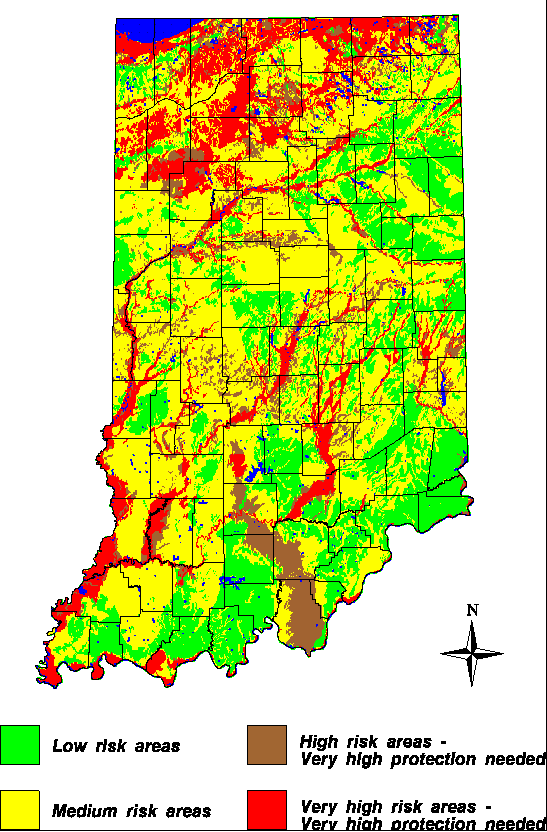
1. Groundwater vulnerability
Groundwater vulnerability depends on a number of soil and geologic characteristics, including depth to the water table, texture of the soil, and bedrock characteristics. For example, groundwater underlying sandy soil is more vulnerable than groundwater under clay soils. Shallow groundwater is much more vulnerable than deeper aquifers. The vulnerability of the geologic area where the well is located is an important factor in determining risk of contamination.The map at left indicates the variability in aquifer vulnerability across the state. Geological areas that are highly vulnerable to groundwater contamination occur in north central and northwest Indiana, where soil is often sandy or gravelly, and in the valleys of all of Indiana's major rivers. Karst areas, where sinkholes provide direct access for potential contaminants to ground water, are also of concern. Areas underlain by glacial till or solid bedrock, including much of central and southern Indiana, are in general less vulnerable. Click here or on the map for more information about the prediction of groundwater vulnerability in Indiana.
2. Well depth and construction
Another important factor influencing contamination levels is the well depth. Shallow wells are much more likely to be contaminated than deep wells. In the Farm Bureau study of private wells, 12.2% of wells less than 50 ft. deep exceeded the drinking water standard, while only 0.9% of wells more than 100 ft.deep exceeded it.Contamination of a particular well can also depend on the well construction. In some cases, the top portion of the well is not adequately sealed when constructed, and contamination occurs around the top of wellhead.
3. Potential sources of nitrate contamination
Septic systems, fertilizer, and livestock wastes are all potential sources of nitrate that can leach to groundwater. It is usually difficult to assess the particular nitrate source when well water is found to be contaminated, since often the contamination is the result of the sum of many sources.Septic systems, especially if poorly constructed or maintained, are a potential source of nitrate and bacteria. Any well located near any part of a septic system (tank, sewer lines or leach field) is at risk for contamination. This risk is increased if the well is shallow, located in sandy or gravelly soil, located downslope from the septic system, or if the well and piping to the home is improperly constructed or maintained. The Indiana State Department of Health requires that septic tanks, dosing tanks, lift stations and soil absorption fields should be at least 50 feet from private wells, 10 ft. from water lines under pressure and 50 ft. from water lines continually under suction.
Fertilizer and animal manures are also potential sources of contamination, and proper management practices are necessary to ensure that nitrogen is applied at the optimum rates and times for crop utilization so that excess nitrogen does not leach to the ground water. Indiana Department of Environmental Management requires that all approved livestock feeding facilities locate manure storages at least 100 ft. from wells and not apply manure closer than 200 ft. to a well.
What we can do
Groundwater contamination by nitrate above the drinking water standard is relatively rare in Indiana, but our generally high water quality should not lead to complacency. Potential nitrogen sources such as septic systems, lawn and field fertilizers, and animal manures must be carefully managed to minimize nitrogen that leaches into the ground water. All well water should be tested at least once per year. Even though the likelihood of detecting contamination is low, it's better to be safe than sorry.For more information, call the Agricultural and Biological Engineering Department at 317-494-1173 to obtain publication MWPS-14, Private Water Systems Handbook ($2.50)
References
Wallrabenstein, L.K.,Richards, R.P., Baker, D.B.,and J.D. Barnett, 1994. Nitrate and Pesticides in Private Wells of Indiana. Indiana Farm Bureau Inc. and The Water Quality Laboratory, Heidelberg College.Risch, M.R. and D.A. Cohen, 1995. A Computerized Data Base of Nitrate Concentrations in Indiana Ground Water. USGS Open File Report 95-468.
By: Jane Frankenberger
Extension Agricultural Engineer
Purdue University
765-494-1194
frankenb@purdue.edu